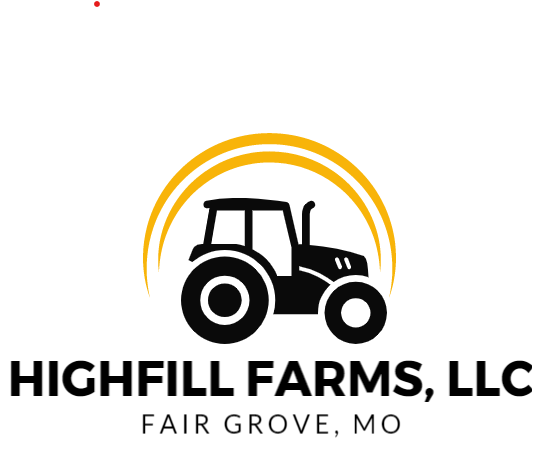To measure the size of a round bale, measure the height and width on each end. Then take the average of these 4 measurements. At Highfill Farms LLC, we sell a 4 ft x 5 ft. This means it is 4 feet wide and 5 feet tall. We try to acheive 5 ft across the top of the bale but there are times when hay feeding into the baler varies side to side and we get the alarm that one size has hit 5 ft and net wrapping begins. We try our best but there can be some variation in bale uniformity.
A break in the rains allowed for spring fertilizer to be applied.
For the 102 acres enrolled in the MFA seed track program, 50 lbs of active nitrogen was applied (120 lbs. treated urea/acre). The shocker was the price of $932/ton vs. about 450/ton last year.
For the other acres, we applied a 3:1:3 at 200 lbs per acre. Price $975/ton.
We are monitoring fields to see where we need to spray. Hope to spray towards the end of April.
On Nov. 10, 2021, we applied 230lbs./acre of Phosphorous and Potassium fertilizer to 102 acres as part of MFA SeedTrak program. The truck that applied the fertilizer used a variable rate to apply exactly what each field needed. This was based on sampling that occurred in Oct. which sampled every 2.5 acres.
We have been making progress on our 1st crop hay harvest. Pastures look good but yields aren't record setting. Could be due to the cool spring and applying a slightly lower rate of fertilizer. Equipment is holding up well. Original concerns with our square baler after I went through a re-timing were deminished as it has been performing very well. Not one sheer bolt and only a few missed ties due to twine changeovers. We have been making some hay shipments as time allows. We will get all our important customers serviced in coming weeks.
Spring Fertilizer was applied April 2 & 3. I applied 2:1:3 which was the general recommendation from soil tests. I applied a lesser rate this year than normal then will plan a second application after first harvest.
Pastures looked very good as I was applying. The past lime applications are really improving the field quality.
Hello,
Big round bales prove challenges in storage. It is best to store them indoors. We have some indoor storage but during harvest, we produce more than our barns will hold. If you must store them outdoors, I'm sharing the recommendations gathered from various Extension departments.
1. Stack bales end to end. This will prevent at least the ends from weathering. If you have long rows of bales, do not allow the sides to touch. Rows should be at least 3 ft. apart to prevent snow accumulation. Orient the rows north to south so the sides get equal sun exposure.
2. Store in open area. Do not store under trees. Once hay gets wet, you want it to dry as fast as possible so keep it in the open air free from trees.
3. Store on rock or elevated surface. Storing on pallets, railroad ties, or tires is also an option. Storing on wet dirt will rot the bottom portion of the bale.
4. Tarping can help but best if it is elevated above the surface of the hay and allow for some air movement. Hay has moisture and if covered too tight with a tarp, it will sweat and cause mold throughout.
I get this question a lot. And it may depend on what part of the country you are looking at. It could even vary here in Southwest Missouri. For us, we often see our 1st crop being the best quality. If we can harvest relatively early, we see very little weed pressure and the hay is not overly mature (stemmy). Also, we don't see any foxtail or Johnson grass. And yields are good so there is plenty so we encourage our customer to take as much as they can of 1st cutting. Some will take their entire winter needs in June. For second cutting, its a gamble. We are very dependent on good timely rains. And hopefully not too hot. Yields are less so we often don't have much to sell. In second cutting, the grass will mostly be finer but could be plagued with weed pressure and foxtail that sets on in July/Aug. Its still good hay but for horse ranchers who are concerned about foxtail, 2nd cuttings will need to managed approriately.
It's March 1st and what a February! Brutal cold temperatures and snow. Pastures are still pretty dormant. We are trying about 1.5 acre of alfalfa/orchard grass as a test plot. We'll let you know how it turns out and if we'll have any bales of this plot available for 2021
It is Feb. 6 in Missouri. The winter has been without much snow for a Missouri winter. In St. Charles we've received a few 2" snows. We've have had some nice rains which will help the early hay crop. We are building our Fertilizer plans for April. The plan this year is to make 2 applications. One in mid-April and one after the first crop harvest.
